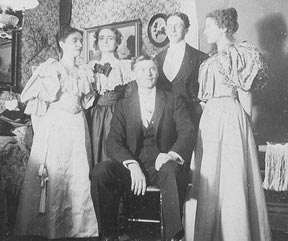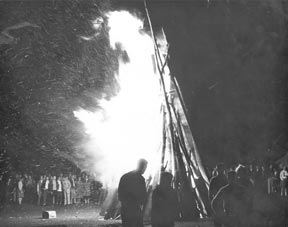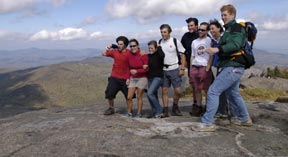Beanies and Boonies:
Traditions of Student Life at St. Lawrence
By Varick A. Chittenden ’63
 Bam! Bam! Bam! The sounds of banging on doors and loud shouts in
the hallways of Men’s Res on weeknights early in my freshman year
are still sharp in my memory. It was time to take a break from studying
and follow “Bum” Steer (St. Lawrence’s star hockey goalie)
and other members of the L Club for a little “orientation.” We
green freshmen would hustle down to the interior quad, or the
Common Room in bad weather, and follow their orders: Do duck
walks in large circles, recite silly verse, do some push-ups, sing a St.
Lawrence song, find our own shoes from a heap we had created. Break
or ignore the rules, pay the price later! It was a tradition,
one of many that were part of student life in the early 1960s.
Bam! Bam! Bam! The sounds of banging on doors and loud shouts in
the hallways of Men’s Res on weeknights early in my freshman year
are still sharp in my memory. It was time to take a break from studying
and follow “Bum” Steer (St. Lawrence’s star hockey goalie)
and other members of the L Club for a little “orientation.” We
green freshmen would hustle down to the interior quad, or the
Common Room in bad weather, and follow their orders: Do duck
walks in large circles, recite silly verse, do some push-ups, sing a St.
Lawrence song, find our own shoes from a heap we had created. Break
or ignore the rules, pay the price later! It was a tradition,
one of many that were part of student life in the early 1960s.
Such behavior,
and the stories told about it, was an important part of college
students’ lives
in our time. We may never have thought of either the behavior or
the stories as folklore because we learned them so casually,
we never really knew where they came from, we shared them with new students
easily and, especially in years after, we didn’t take them very seriously. But
on closer examination, life for many at St. Lawrence–whenever we
were students–was
full of rituals, celebrations, legends, tall tales, heroes
and villains.
In the 150-year history of St. Lawrence, many
customs have come and gone; others have survived. Daily
religious services (with required attendance), debating societies
and annual class banquets all had their day and are long gone.
On the other hand, the daily ringing of the chimes of Gunnison
Memorial Chapel has been a ritual for going on 80 years.
 Annual
institutional traditions, like Convocation, the Candlelight
Service (now the Service of Lessons and Carols), ODK tapping, Commencement
and Reunion Weekend, each has a carefully crafted series of events and
prescribed roles for faculty, students or others. Seldom
do these vary much. They confirm order and dignity in the academic
world. How
can we forget the warmth and beauty of the chapel decorated
for the holidays and completely bathed in the light of hundreds of small candles
lifted high in the air, or the colorful regalia of professors purposely marching
a little out of step into the rows of chairs at graduation each spring?
Annual
institutional traditions, like Convocation, the Candlelight
Service (now the Service of Lessons and Carols), ODK tapping, Commencement
and Reunion Weekend, each has a carefully crafted series of events and
prescribed roles for faculty, students or others. Seldom
do these vary much. They confirm order and dignity in the academic
world. How
can we forget the warmth and beauty of the chapel decorated
for the holidays and completely bathed in the light of hundreds of small candles
lifted high in the air, or the colorful regalia of professors purposely marching
a little out of step into the rows of chairs at graduation each spring?
No Questions Asked
It’s the informal and student-generated traditions, however, that
most of us remember from our undergraduate years. For me, it all
began the day I arrived on campus in September 1959. Shortly after
we unloaded my parents’ car and I saw them off, I was directed to
a small room where I was given a pile of goods that I was told
to value with my life: a scarlet and brown beanie about three sizes too
small, a bright red bow tie, and a large white placard with a loop of string
attached, on which was written in large black Magic Marker letters my name
and hometown. Like
every other entering student, from that minute forward I was
to wear them all in public until notified otherwise, no questions asked.
That
was the first of many St. Lawrence traditions I encountered
in my college life, most of which I remember fondly to this day. Freshman
hazing–a
term that seems a little harsh when it describes much more destructive
behavior today than any we knew--was not much fun at the time.
Big Weekends
 In that same era, Homecoming Weekend was a highlight for many
students. There were several other big social weekends in the year
as well; most have diminished or, like Homecoming, disappeared. For
Sigma Chi, Derby Day featured games on the Quad and a big dance or a concert
or both-- in 1962, Louis Armstrong filled Appleton Arena with students
and townspeople. The SAEs broke up the doldrums of winter with Yukon Day,
complete with beard contests and sled races. Leigh Berry ’64 remembers
MERP (Male Economic Recovery Program) Weekend, akin to Sadie Hawkins Day,
when women asked men to be their dates. Leigh says, “I never
had much money, so I had to be creative, but that made it more fun.”
In that same era, Homecoming Weekend was a highlight for many
students. There were several other big social weekends in the year
as well; most have diminished or, like Homecoming, disappeared. For
Sigma Chi, Derby Day featured games on the Quad and a big dance or a concert
or both-- in 1962, Louis Armstrong filled Appleton Arena with students
and townspeople. The SAEs broke up the doldrums of winter with Yukon Day,
complete with beard contests and sled races. Leigh Berry ’64 remembers
MERP (Male Economic Recovery Program) Weekend, akin to Sadie Hawkins Day,
when women asked men to be their dates. Leigh says, “I never
had much money, so I had to be creative, but that made it more fun.”
Then there were the Mistletoe Ball, the Alpha Auction and,
of course, Winter Carnival, a high point of the year especially
for Greeks with their healthy rivalry to build the most ambitious and spectacular
thematic snow sculptures. For sorority women, one of the fondest
end-of-year traditions was the strawberry breakfasts at their houses on
Moving-Up Day weekend.
Expressions of Belonging
People in institutional settings, especially those without
much power, often create ways to cope. Thus it has always been
with students, and those informal ways that are in defiance of rules or norms
often become entrenched. They are passed down, are learned by word-of-mouth
or example, and are subject to variation, particularly from place to place.
These expressions of identification with St. Lawrence, or with
a smaller community within it (a Tri-Delt, a hockey player, a Laurentian Singer),
whether oral, musical, behavioral or material, are folklore.
For
nearly everything, regardless, it seems there is a story. I remember
some, most likely half-truths and rumors or exaggerations,
but they’re
part of how I think of St. Lawrence. Professors were good for
a few. Prof. William Mallam let his dog into his early-morning history classes
after his lecture began, but not his students. Those of us who took Constitutional
Law lived in fear of Dr. Harry Reiff, a brilliant, old-school
professor who was very demanding and authoritarian. Every long Wednesday night
was “give
your life to Reiff night” as we prepared for his weekly tests on
court cases. Dean of Women Doris Stout was widely reputed to
require “girls” not
to wear red since it provoked passionate behavior, or patent
leather shoes since they could act as mirrors.
Tradition and Change
Shortly after my time at St. Lawrence, life for students began
to change significantly. Civil rights, Vietnam, Watergate,
the women’s
movement: as on many campuses, St. Lawrence students were
finding their own voices in response to those broader social
movements. “Tradition” stood
for the old authority and conformity--exactly what students
of the late ’60s
thought needed changing. Ginny Schwartz, who came to St. Lawrence
in 1971 as dean of freshman women, part of a growing staff
of professional student service personnel, says that colleges
like St. Lawrence began creating “a gentler, more nourishing learning
and living environment.” She
and her colleagues sought to alter St. Lawrence to succeed
with a new generation of students.
 Yet, Schwartz
maintains that students seem to be hungry for traditions. “They want
to feel part of something that’s been around a while,” she says. “In
fact, they often seize on something that’s been going on for only three
or four years and insist that it’s a tradition.”
Yet, Schwartz
maintains that students seem to be hungry for traditions. “They want
to feel part of something that’s been around a while,” she says. “In
fact, they often seize on something that’s been going on for only three
or four years and insist that it’s a tradition.”
In response to that need, some “traditional” campus activities
in recent years have been initiated by administrators, although
students have often picked up the ball. The Outing Club of old was
revived in Peter Van de Water’s day in student services in the 1980s,
and continues to thrive; its Peak Weekend, when at least one
St. Lawrence student climbs to the top of each of the 46 Adirondack high
peaks, has become a fall highlight. The Quad Experience, begun by Schwartz
and the staff in the early 1970s as an experiment in introducing first-year
students to college life, with group activities and games, is today more
formal, with remarks by the president and dean and some rituals, like passing
torches to light candles.
Traditions,
old or new, satisfy a need in all of us. While we may not have thought
much about St. Lawrence folklore at the time, these informal
moments–and
many more–that we took for granted were significant, when silly behavior
was serious and becoming part of something much bigger than
each of us was very important.

